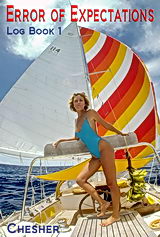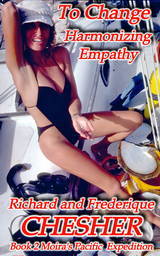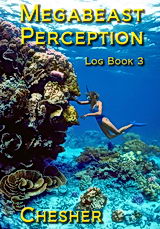Cells dance to become our larger form.
We are one acting as many.
We are many acting as one
Acting as many
This colony of coral is composed of two species of Acropora coral, one purplish, the other yellow-brown.
The larvae of the two species settled so close together they grew into one thicket.
The uniform, domed shape of the thicket, advantageous to both species, is the result of the coordinated growth patterns of the branches.
But how do the two species communicate to co-ordinate their growth patterns into one domed shape?
How does even one colony co-ordinate its growth to create the overall domed shape? The branches are all dead at the base and so the living tissue from one does not connect to the next.
Acting as one
Like the individual fish forming the
communication web above the thicket, each branch is an individual; isolated from its
companions in the sea. Unlike the fish, the living coral leaves a calcium carbonate
skeleton behind it as it grows, crystallizing its communication web.
The still photograph of the coral branch is an accurate representation of the trajectory of the living branches over many years.
The twisting rods of calcium carbonate are memory traces of all the intercommunications influencing the life of the coral. They are solidified behavior zones.
Acting as many
Each branch detects changes in water turbulence, nutrient availability, and
illumination to direct its rate and trajectory of growth and maintain its position
relative to other branches.
To achieve this, the branch has an intricate communications system within the thin, diaphanous flesh covering the hard skeleton.
The domed shape of the whole coral thicket is the combined communication web of the branches and is fashioned by hormonal and electrochemical communications - the branch's awareness - about differences from one part of the branch to another in, for example, the success of the polyps in obtaining nutrients and sunlight and the impinging communication webs of adjacent branches and the sea around it.
In the end, the pathway of the coral through the sea is determined by the entire web of communications, including the fish that fertilize it and the sun that provides it with energy and the sea from which it forms itself.
One web of intercommunications nested in layers of focal points
On close inspection, the exterior of each branch is not uniform, but arranged into small sea-anemone shaped creatures, each with its own mouth, tentacles for grabbing food, reproductive organs, and its own calcium carbonate skeleton - a crystallized memory - lifting it into the sea in a raised cup.
Each polyp is a communication web extending into the sea as far as its tentacles can reach.
The whole branch is communication web of the polyps in the same way the whole colony is the communication web of the branches.
Moving deeper into the nested layers
Reef building corals are made of polyps interacting as individual colonies. Looking closer at the polyps and then a tentacle reveals the creature to be the communication web of a community of two kinds of creatures. The white oblongs are coral cells. These are tiny polymorphic animals. They can change their bodies into some 250 different basic shapes, each with their own special communication abilities. Their combined network of communications forms the shape and movement of the coral tentacles, disk, organs, skin, and nerves.
The tiny green spheres are dynoflagellates. These can alter their shape between a free-swimming protozoan or a small round, green zooxanthellae living in the spaces between the coral cells. They contain chlorophyll and can change sunlight, water and carbon dioxide into oxygen and sugars.
Manifestation as a "physical" entity
The physical manifestation of the coral polyp is the web of intercommunication between millions of coral cells and zooxanthellae, a behavior network that has existed for at least 200,000,000 years.
A single, small coral cell whose body forms, for example, a tiny part of the end of one tentacle relies on the communications (nutrients, hormones, electrochemical discharges, and tactile signals) between itself, adjacent cells and zooxanthellae to know how to behave to maintain the desired polyp-tentacle shape and movement.
The cells can exist for a short time
by themselves, alone in the sea.
Cells of some creatures, such as sponges, can be broken free from their association and they will crawl back together and reform into another sponge. All plants and animals are made up of cells. Although they have separate genetic memories, the cells are otherwise alike.
Looking still closer, cells are, themselves, communication webs of bacteria. The ancestors of these bacteria once were the most advanced form of life on Earth and lived in the ancient seas some 3 billion years ago. Today, these same creatures exist as cell nuclei, mitochondria, centrioles, cilia, and chloroplasts.
The protobacteria intercommunicate to create the web of communications we call cells.
Immortality
Not one of the protobacteria in the coral cells has ever died.
They have divided and divided down through the 200,000,000 years constantly, and continuously creating themselves from the sea water and creating, from their behavior, the coral cells and these creating the coral polyps and coral colonies.
Molecular webs of communications
Bacteria are, themselves, created as information flows through the communication web of millions of large, complex organic molecules. The largest of these is called DNA. DNA, and their associated organic molecules, are selves existing through the interchange of information with adjacent molecules.
The cumulative communication web of the DNA and associated organic molecules becomes the form and movement of cell nuclei, chloroplasts, mitochondria or cilia.
Except for the kinds of information recorded in the organic molecules, and some very specialized compounds, all living creatures share the same basic set of organic molecules.
Atomic webs of communications
DNA molecules are, themselves, communication webs created by the intercommunication of atoms of oxygen, hydrogen, nitrogen, carbon and phosphorous. The intercommunication of these elements in highly complex patterns results in molecular replication (memory).
Atoms are communication webs of electrons, protons, neutrons and a multitude of other sub-atomic particles. The sub-atomic particles are focal points of intercommunications of quarks and leptons reacting to forces carried by bosons, photons and gluons.
Physicist Roger Penrose of Oxford suspects that ultimately the basic structure of reality is comprised of Twisters. Twisters, he says, are the intercommunications of concepts and conditions, each existing as different facets of one process.
To delve further into this process, check out the Torus Concept.



